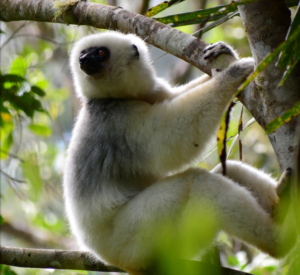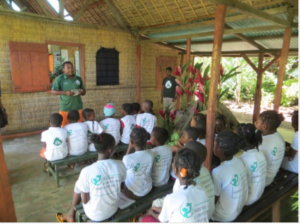Saving the Silky Sifaka
The SAVA region of Madagascar, nestled in the northeast corner of the island, is made up of dense rainforests, high mountains, bustling cities, and beautiful coasts. Home to over 1 million citizens, the SAVA region also boasts incredible biodiversity. Nearly 250 species of invertebrates make their home in the rainforests of the SAVA region, many of which are found nowhere else on the island or in the world.
One of the 11 lemur species living in this region is the silky sifaka (Propithecus candidus), or the simpona fotsy in Malagasy. The silky sifaka is a critically endangered species, with only 250 individuals known to remain in the wild. Because of its beautiful appearance and its extreme conservation needs, the silky sifaka has become a flagship species for the SAVA region, and many local and international conservation groups have been working hard to protect the forests there in order to save the silky sifaka and the abundance of other wildlife that it represents.

A silky sifaka. Photo by Laura de Ara.
Seeing a silky sifaka in the wild is a remarkable experience. Nearly 3 feet long, swathed in long, silky, white fur, the silky sifaka can leap long distances from tree to tree almost noiselessly. They are ethereal animals, once impossible to find, but now so well-researched and tracked that they are easier to spot in protected forests like Marojejy National Park. The silky sifaka is one of 9 recognized species of sifaka in Madagascar, all of which are critically endangered. Silky sifakas rely on primary forest habitat to thrive.
Researchers from SAVA Regional University Center (CURSA) and other universities, park rangers, and conservationists have been tracking silky sifaka populations for years, hoping to understand more about this vulnerable species. Obtaining an accurate count of any species is challenging, but it is important to monitor the number of individuals remaining, and to identify what parts of the forest they use, how far they travel, and what challenges they face.

Silky sifaka range in the SAVA region of Madagascar.

A group of lemur conservationists works in the COMATSA region of Madagascar.
Research groups like the one at CURSA are creating important change in the SAVA region with help from larger Malagasy and international entities (including the DLC). Recent projects have focused on population counts, distribution mapping, and increasing understanding of specific conservation threats. Armed with this knowledge, conservationists can create site-specific and species-specific strategies to protect crucial habit areas and the wildlife within them.
One recent study identified the importance of a habitat corridor created in 2015, connecting several national parks. This corridor allows wildlife to move freely throughout these protected areas, and the study proved just how often the corridor was being used, and how crucial its protection is to the survival of species like the silky sifaka. This study also surveyed people living in 3 different sites in the SAVA region about hunting practices, and showed that hunting of lemurs was common in all 3 areas due to lack of available protein. Community focus groups were then formed to discuss more sustainable protein sources, and take the pressure off wildlife. Increasing access to education, spreading the word about the silky sifaka and conservation needs in the SAVA region, and providing more opportunities for people to get involved are all crucial aspects of projects like these.

Habitat corridors connect major protected areas in the SAVA region, which help conserve species.

Students learn about lemur conservation.
People across the SAVA region and the world are coming together to protect critically endangered species like the silky sifaka, and hope remains that this population will continue to grow and thrive for many years to come. While some conservation issues may seem too large and complex to solve, every effort that is made to save species, however small, makes a big difference.
References
Patel, Erik R. “Silky Sifaka.” Primates in Peril: 38.
Patel, Erik R. “Synthesis of the silky sifaka’s distribution (Propithecus candidus).” Madagascar Conservation & Development 11.1 (2016).
Schüßler, Dominik, et al. “Identification of crucial stepping stone habitats for biodiversity conservation in northeastern Madagascar using remote sensing and comparative predictive modeling.” Biodiversity and Conservation 29.7 (2020): 2161-2184.
Spira, C, Raveloarison, R, Cournarie, M, Strindberg, S, O’Brien, T, Wieland, M. Assessing the prevalence of protected species consumption by rural communities in Makira Natural Park, Madagascar, through the unmatched count technique. Conservation Science and Practice. 2021; 3:e441. https://doi.org/10.1111/csp2.441
Rabevao Edgar, et. Al. “Ecology and conservation of lemurs in the COMATSA protected area and importance of the corridor for threatened species”. Duke Lemur Center, Dec. 22 2021. https://lemur.duke.edu/ecology-and-conservation-comatsa/

